Introduction
In the pursuit of fitness, understanding the intricate workings of the abdominal muscles can be a game changer. The core isn't just about aesthetics; it's the powerhouse that drives every movement, stabilizes the body, and supports overall health. By delving into the anatomy of the abs and recognizing the unique roles of muscle groups like the rectus abdominis, obliques, and transverse abdominis, individuals can tailor their workouts for maximum impact.
This article explores proven exercises and essential practices that not only build strength but also enhance core stability, reduce injury risk, and debunk common fitness myths. With a comprehensive approach to ab training, readers will discover how to effectively integrate these workouts into their routines, fostering a resilient and powerful core that supports their fitness journey.
Understanding Abdominal Anatomy and Its Importance for Strength
To truly unlock the power of your workouts, a deep understanding of the anatomy of your abdominal structures is essential. The abdominal region consists of three key groups:
- The rectus abdominis
- Obliques
- Transverse abdominis
The rectus abdominis is famously recognized for creating the coveted 'six-pack' look, and it plays a pivotal role in flexing the spine.
On either side, the obliques contribute to rotation and lateral flexion, enhancing your ability to perform dynamic movements. Meanwhile, the transverse abdominis acts as an essential stabilizer for your midsection, providing crucial support during various activities. By understanding the distinct roles of these tissues, you can create a focused workout plan that not only enhances your abs strength but also improves your overall health.
Recent research provides baseline data on normal abdominal wall anatomy and its implications for physical function and quality of life, particularly in a healthy nulliparous female cohort. This comprehension enables you to participate in efficient activities that foster a stronger, more resilient center, establishing a solid groundwork for your fitness journey. As noted by Dr. Jana Vasković,
If we go deeper into the anterolateral abdominal wall, beneath the superficial fascia we will find the muscular layer.
Furthermore, insights from the case study titled 'Limitations of Current Tissue Studies' highlight the challenges in estimating lengths and force-generating capabilities, underscoring the need for abs strength training to combat the effects of tendon compliance and tissue function.
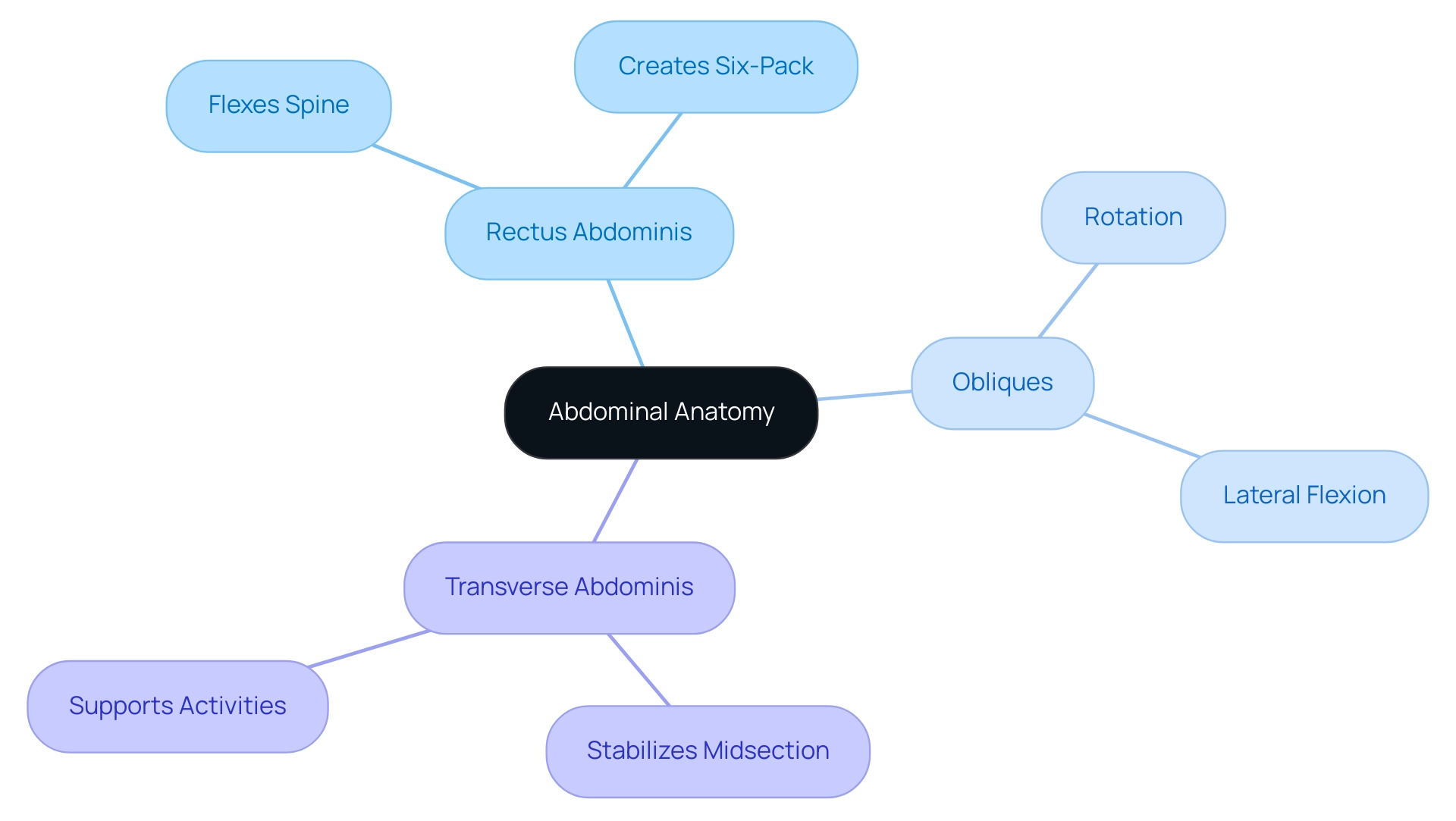
Proven Exercises for Building Strong Abs: Techniques and Tips
Developing abs strength necessitates a mix of traditional and dynamic workouts that effectively engage deep abdominal muscles. Among the most impactful moves are:
- Crunches
- Planks
- Leg raises
Alongside dynamic activities like:
- Bicycle crunches
- Mountain climbers
Significantly, the plank distinguishes itself as a thorough central workout, targeting not only the front abdominal muscles but also involving the entire midsection for optimal advantage.
Recent research has indicated that movements such as crunches can provoke EMG activity of about 0.09 mV, emphasizing their efficiency in strengthening the abdomen. To maximize results, focus on maintaining proper form and breathing while also enhancing your abs strength throughout each movement. Start with sets of 10-15 repetitions, progressively increasing as your strength develops.
For an added challenge, consider incorporating variations such as:
- Weighted planks
- Hanging leg raises
Furthermore, the highest TA activation has been noted with suspension training systems utilizing the side-lying lumbar position, indicating that these techniques can be especially beneficial for abdominal training. A case study on unilateral activities revealed that the External Oblique demonstrates substantial EMG activity during movements like the Bulgarian squat and standing unilateral dumbbell press, emphasizing the importance of stabilization against lateral sway.
By incorporating these exercises into your routine, you can develop abs strength that contributes to overall health and wellness. As noted by J.M.M., 'All authors have read and agreed to the published version of the manuscript,' underscoring the collaborative effort behind these findings.
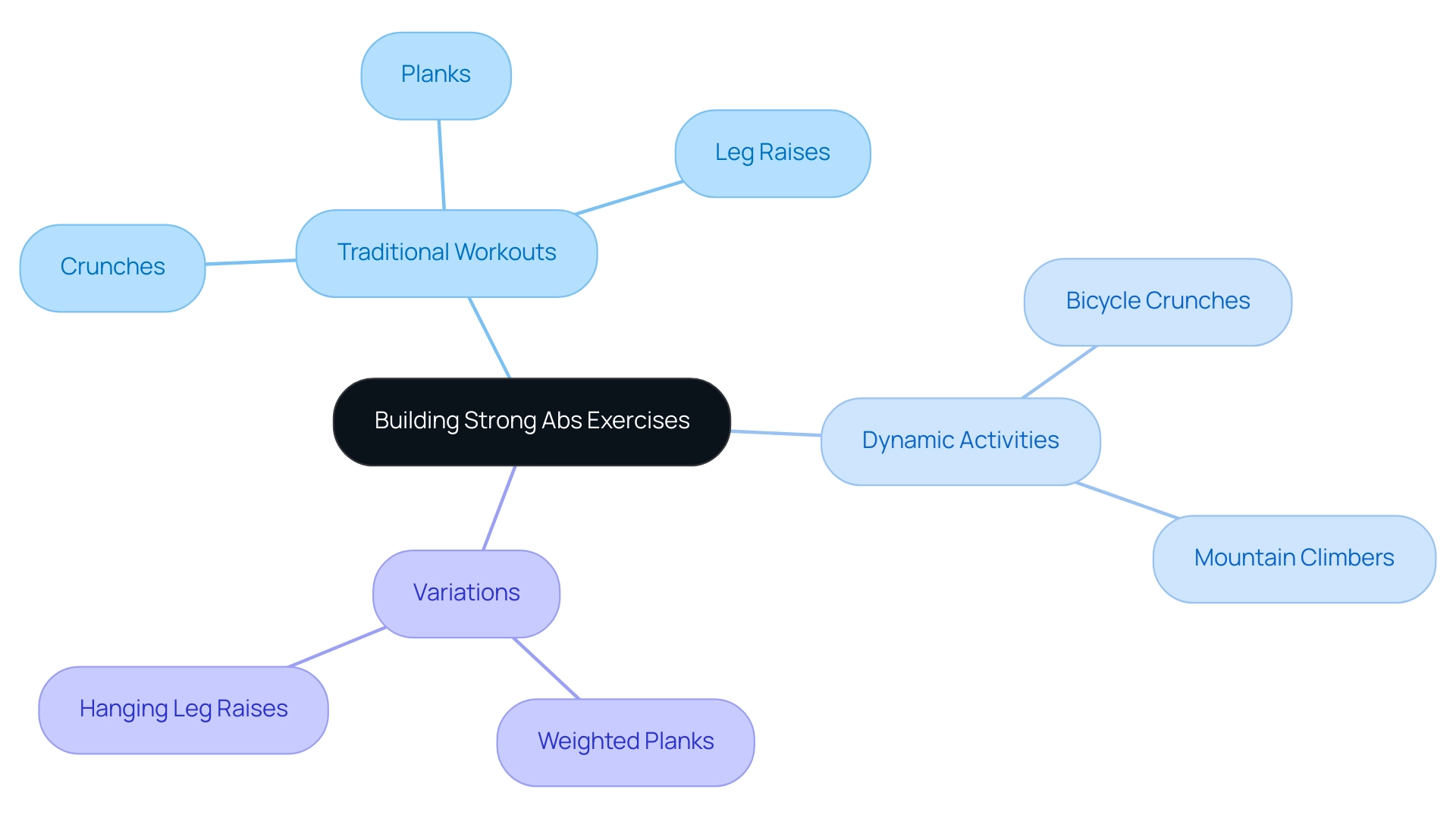
The Role of Core Stability in Enhancing Overall Fitness
Core stability is a cornerstone of maintaining balance and proper posture, essential elements that directly influence overall fitness. A strong center not only supports dynamic movements in running and lifting but also plays a crucial role in everyday activities, such as sitting and standing. Research indicates that individuals with strong central strength experience significantly lower injury rates, with studies showing that those with improved central stability can reduce lower back injury rates by up to 50%.
To develop fundamental stability, consider integrating exercises that challenge balance, such as:
- Stability ball workouts
- Single-leg exercises
These workouts not only improve abs strength but also engage various muscle groups, promoting a comprehensive approach to fitness. As K.D., a renowned author, highlights, "These results indicate that it is essential to properly design fundamental training programs to enhance sport-specific athletic performance."
This emphasizes the need for customized training programs that can enhance performance and reduce injury risks. Additionally, the Core Four-Direction Endurance Test demonstrates the significance of maintaining proper alignment during endurance assessments, as deviations can lead to inaccurate measurements and potentially hinder training effectiveness. By prioritizing essential strength, you not only enhance performance but also contribute to injury prevention, fostering a healthier and more resilient team.
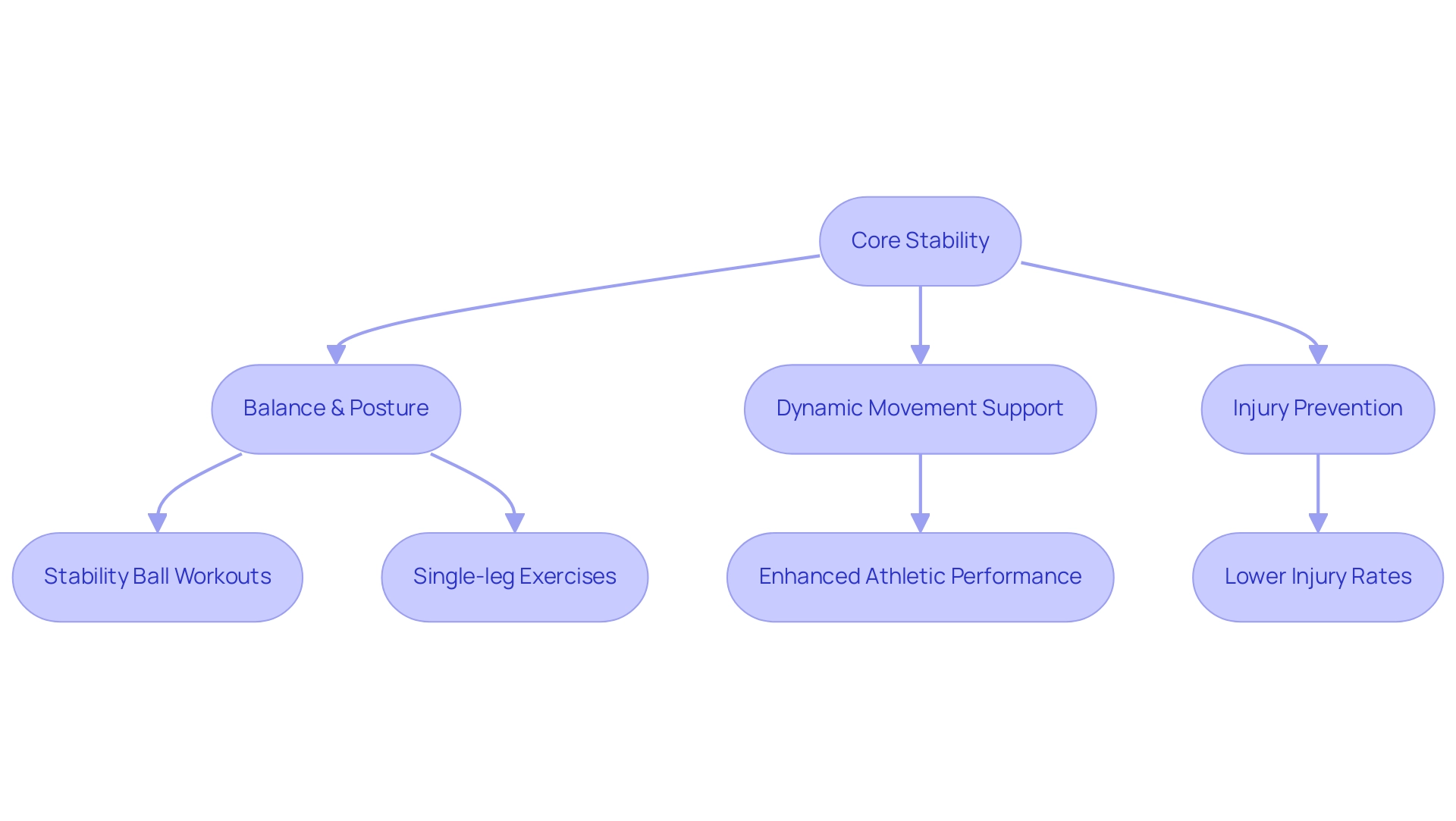
Debunking Myths: The Truth About Ab Workouts and Fat Loss
A prevalent myth in the fitness world is the belief that solely performing ab workouts will result in substantial fat loss, especially in the belly region. Spot reduction has been debunked; effective fat loss generally arises from a combination of overall caloric expenditure and a well-balanced diet. While activities aimed at the abdominal muscles can enhance abs strength and core strength, they do not solely contribute to fat loss in that specific area.
To effectively shed belly fat, it's crucial to incorporate a full-body workout routine that enhances abs strength, including cardiovascular activities and strength training, along with nutritious eating habits. As Deviny Mo, General Manager of UCLA Health Sports Performance, aptly states,
But you can’t just pick up a package that says keto on it if you’re trying to lose weight. You have to do your research.
This principle extends beyond diet to exercise; understanding the realities of fat loss can empower individuals to pursue their wellness goals more effectively. Moreover, hydration plays a supportive role; while drinking water can aid digestion and appetite control, it is not a standalone solution for burning belly fat. In fact, participants who drank 500ml of water showed a 30% increase in metabolism, although this effect was short-lived.
A case study titled 'Myth #9: Drinking Water Alone Can Burn Belly Fat' confirmed that while hydration is vital for health, it does not independently incinerate fat. Thus, the path to a healthier body lies in embracing a comprehensive approach that emphasizes overall well-being, rather than relying solely on isolated activities.
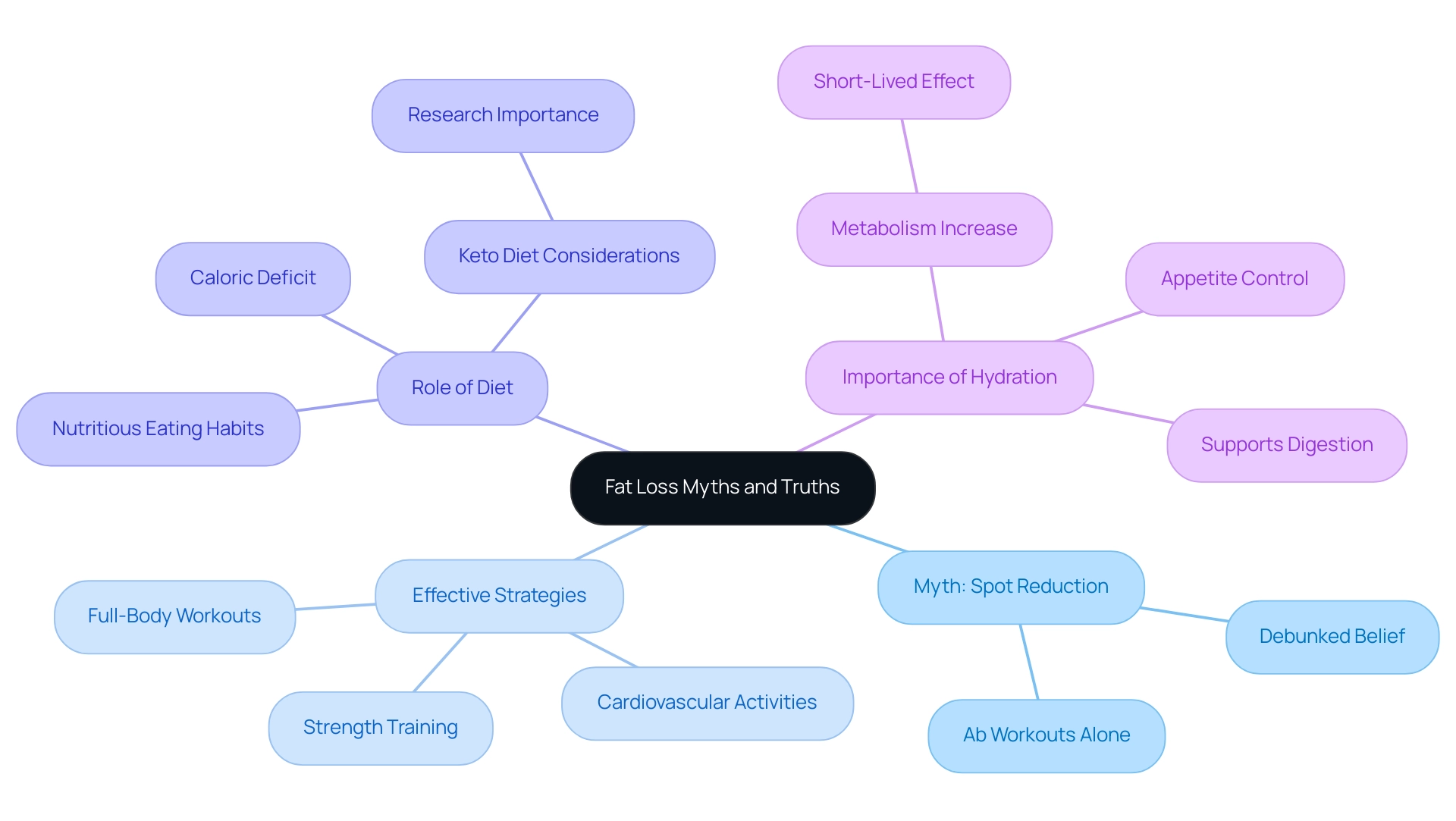
Integrating Ab Workouts into Your Fitness Routine: Best Practices
To successfully incorporate workouts that enhance abs strength into your exercise routine, aim to schedule these exercises at least two to three times a week. This frequency allows for essential recovery days between sessions, fostering optimal muscle growth and strength. Research shows that personalized corporate wellness programs, such as those we provide through our Customized App, improve employee health and productivity, emphasizing the significance of consistency in exercise routines.
Each team member also receives individualized guidance and support from a dedicated health coach, ensuring a personalized approach to their wellness journey. Consider combining ab training with other types of strength or cardiovascular workouts to enhance abs strength and develop a comprehensive exercise regime. For example, you could include abdominal routines into your warm-up or cool-down phases, or even integrate them into circuit training sessions for added variety and intensity.
As Doug Tyson, AP® Statistics instructor and table leader, emphasizes, integrating varied training methods can improve overall health outcomes. To maintain enthusiasm and prevent workout plateaus, mix up your ab exercises to improve your abs strength by targeting different areas of your core. By investing in expert-designed curated workout programs, you empower your team to achieve muscle gain, weight loss, endurance, and overall health.
The iterative method demonstrated in our wellness programs can result in successful outcomes; likewise, consistently revisiting and adjusting your exercise routine can yield significant improvements in abs strength as part of your strength-building endeavors. By embracing these strategies, you’ll not only enhance your consistency but also witness substantial gains in your team's fitness journey.
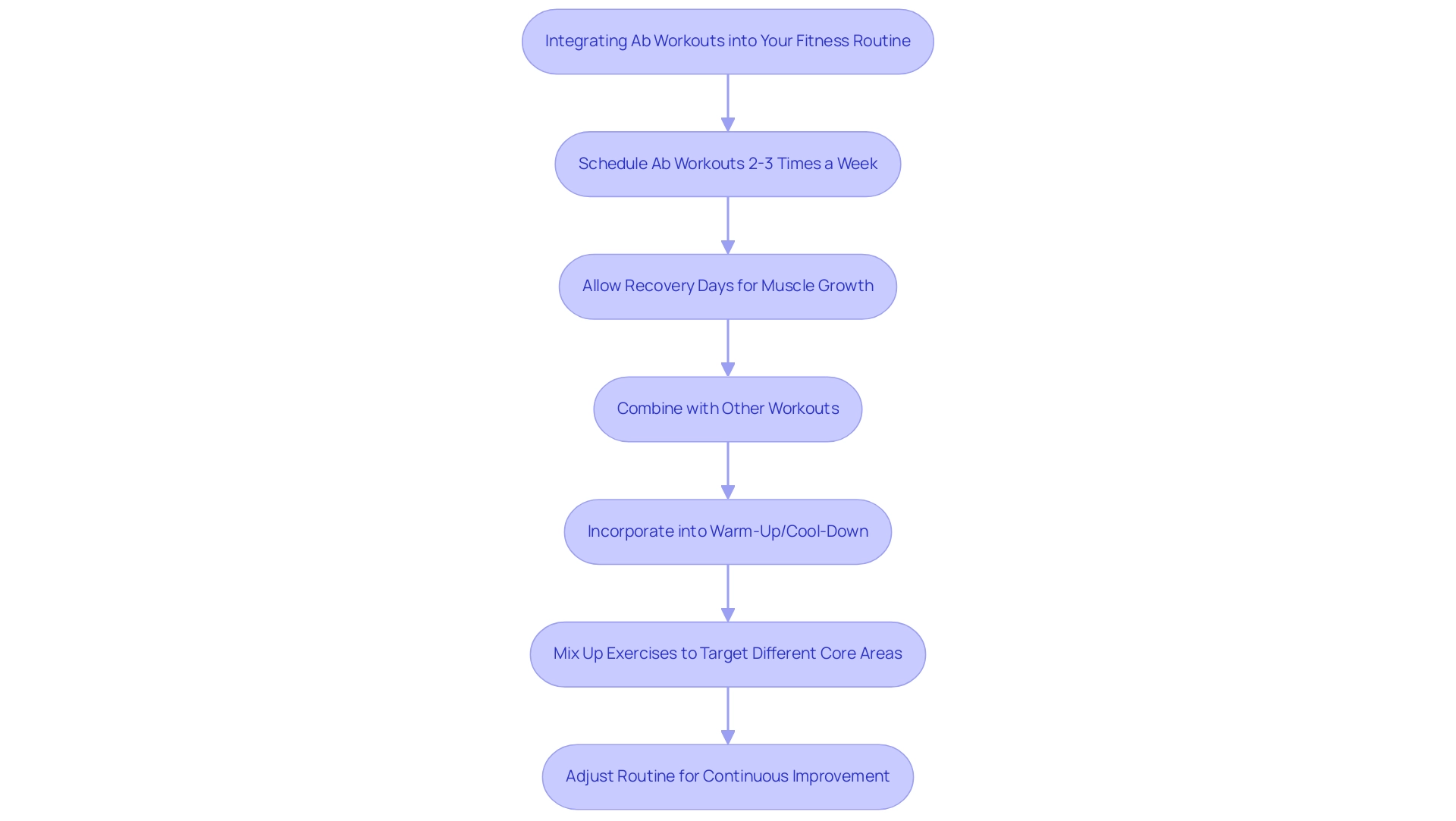
Conclusion
Understanding the intricacies of abdominal anatomy, effective exercises, and core stability is essential for anyone looking to enhance their fitness journey. By recognizing the roles of the rectus abdominis, obliques, and transverse abdominis, individuals can tailor their workouts to build strength and resilience. Incorporating a variety of exercises, from traditional crunches to innovative planks, ensures a comprehensive engagement of the core muscles, leading to improved stability and performance.
Furthermore, debunking common myths surrounding ab workouts and fat loss clarifies that a holistic approach is necessary for achieving fitness goals. Spot reduction is a fallacy; true fat loss requires a well-rounded routine that includes:
- Cardiovascular training
- Strength training
This routine should be complemented by a balanced diet. Emphasizing hydration and the importance of overall well-being fosters a healthier lifestyle.
Finally, integrating ab workouts into a consistent fitness routine not only boosts core strength but also enhances overall physical health. Scheduling these exercises regularly and combining them with other training methods can lead to significant improvements in fitness and performance. By prioritizing core strength and embracing a comprehensive approach, individuals can cultivate a powerful core that supports their overall fitness aspirations, paving the way for long-term success and vitality.
Frequently Asked Questions
What are the key groups of abdominal muscles?
The abdominal region consists of three key groups: the rectus abdominis, obliques, and transverse abdominis.
What is the function of the rectus abdominis?
The rectus abdominis is known for creating the 'six-pack' look and plays a crucial role in flexing the spine.
How do the obliques contribute to physical movement?
The obliques are responsible for rotation and lateral flexion, which enhances the ability to perform dynamic movements.
What role does the transverse abdominis play in the body?
The transverse abdominis acts as a stabilizer for the midsection, providing essential support during various activities.
Why is it important to understand abdominal anatomy for workouts?
Understanding the distinct roles of abdominal muscles allows for the creation of a focused workout plan that enhances abs strength and improves overall health.
What types of workouts are effective for developing abs strength?
Effective workouts include traditional exercises like crunches, planks, and leg raises, as well as dynamic activities like bicycle crunches and mountain climbers.
Why is the plank considered a thorough central workout?
The plank targets not only the front abdominal muscles but also engages the entire midsection for optimal advantage.
What is the recommended approach for performing abdominal exercises?
It is recommended to focus on maintaining proper form and breathing, starting with sets of 10-15 repetitions and progressively increasing as strength develops.
What variations can be added to traditional abdominal exercises for more challenge?
Variations include weighted planks and hanging leg raises.
What recent research findings support the effectiveness of certain abdominal exercises?
Research indicated that movements like crunches can provoke significant EMG activity, highlighting their efficiency in strengthening the abdomen.
How does suspension training benefit abdominal training?
Suspension training systems using the side-lying lumbar position have shown to produce the highest transverse abdominis activation, making them beneficial for abdominal workouts.
What insights were gained from studies on unilateral activities related to the obliques?
Studies revealed that the External Oblique demonstrates substantial EMG activity during movements like the Bulgarian squat and standing unilateral dumbbell press, emphasizing the importance of stabilization against lateral sway.

